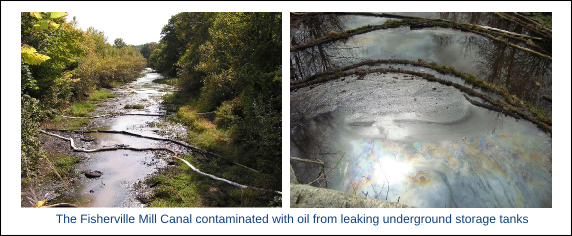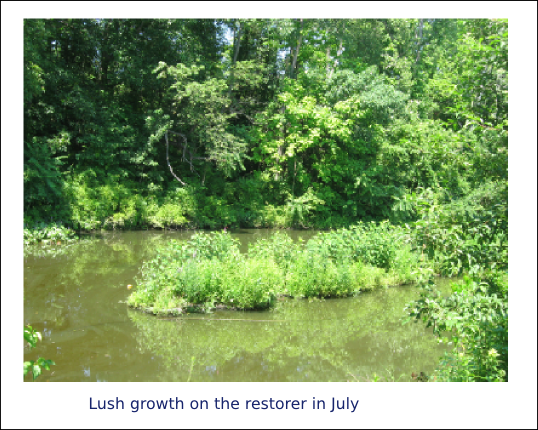
The Eco-Machine at the Fisherville Mill Canal
Grafton, Mass.
The Blackstone River flows through what was the heart of the American industrial revolution. Its banks were lined with impoundments, canals and water-powered mills. The Fisherville Canal Restorer is located downstream of long active mill site with a complicated but telling history.
THE HISTORY
The Fisherville Mill site had been an industrial site in operation since the 1830s. Its history tells the story of manufacturing in America. The mill, producing first cotton textiles, later tool and die, and finally lawn furniture and foam rubber, closed its doors in 1986. In 1999 a huge fire burned it to the ground and left behind toxic rubble on top of an already degraded environment. The site underwent a five year cleanup effort where much of these materials, including two 20,000 gallon underground oil storage tanks, were removed. What could not be removed was a heavily degraded canal choked with legacy contaminants and canal banks containing high levels of Bunker C. Crude oil, which leaches into the canal with each rain storm.
AN ECOLOGICAL APPROACH
In 2006 an extensive interagency and inter-discipline coalition contacted John Todd to see if a version of our restorer technology could be a solution. The restorer is an in-situ remediation approach developed over many years and has been used to bring back to health canals heavily loaded by sewage and ponds choked by excess nutrients. While Dr. Todd has experience treating many tricky contaminants, high strength wastes, pesticides like DDT and pharmaceuticals, the tar-like bunker c oil was a new challenge.
A pilot study beginning in 2006 added to our ecological treatment train cells of mycelium know for their capacity to break down petroleum hydro-carbons. After a year of data collection where we saw a reduction of 60 to 90% in total petroleum hydrocarbon concentrations, we knew enough to begin our scale design.
The Fisherville Canal Restorer is a hybrid of in-stream and side stream technologies. Taken together they create a powerful circulating loop of healthy ecology, a stream within the stream in which water is purified and the canal is re-seeded with healthy ecology. The system consists of four powerful stages of treatment.
HOW IT WORKS
Stage One
Sediment Digesters:
Untreated water from the river flows into a gravel filter which is colonized with bacteria and other biological organism. The gravel filters sit beneath a blanket of sediment and draw contaminated water up into the greenhouse using a pump. In these filters the oil is heavily concentrated and its biological breakdown begins.
Stage Two
Myco-Reactors:
Coming from the sediment-digestor water is then trickled through wood chips contained in a series of black plastic bins. The wood chips house spongy mycelium, which is the web-like tissue of fungi as it forms mushrooms. The myco-reactor bins contain fungal species, embedded in the wood chips, known to secrete enzymes capable of breaking down petroleum hydro-carbons and which are effective at removing other contaminants as well. Enzymes collect in the water passing through the system and are then pumped into the next stage of treatment.
Stage Three
Aquatic Cells:
Water then flows into a series of six vertical tanks called, Aquatic Cells, housing a diversity of algae, bacteria, protozoa, zoo plankton, snails and fishes. Shrubs and emergent plants grow from racks floating within these tanks. Water passing through this system comes into prolonged contact with these living communities and is purified, aerated, and seeded with living organism before it is discharged to the final stage.
Stage Four
Floating Restorer:
The water is then discharged back into the river to flow through a thickly-planted floating raft called a restorer. Water from the greenhouse is discharged here through a series of sprinkler nozzles and flows through fruiting mushrooms and root zones before re-entering the canal. The floating restorer creates a pocket of clean oxygen and life-rich water and attracts a high concentration of insect life, minnows, carp, snapping turtles, painted turtles and frogs.
WHAT IT MEANS, OUR HOPES FOR THE FUTURE
The overall purpose of the Eco-machine is to provide large numbers of beneficial organisms to the canal on a year-round basis. It functions as an ecological incubator, providing a sufficient density of life forms from the various kingdoms of life to digest the oils and transform the ecology of the canal to a healthier state. Water from the Grafton Eco-machine flows back to the Restorer zone in the canal. The concept of an ecological incubator is new and quite radical, but its potential for water quality improvement is very real.
During the system's first year of operation a reduction in excess of 95% of petroleum hydrocarbons contaminating the river water was seen throughout the system.
Today we are eager to build on this success and expand the project to begin restoring impoundments and degraded water along the entire length of the Blackstone River and its adjoining canals. We are seeking partners and support to help in this mission and have begun joining with local universities to create the Living Systems Laboratory, an educational consortium capable of sustaining and learning from this important work.







